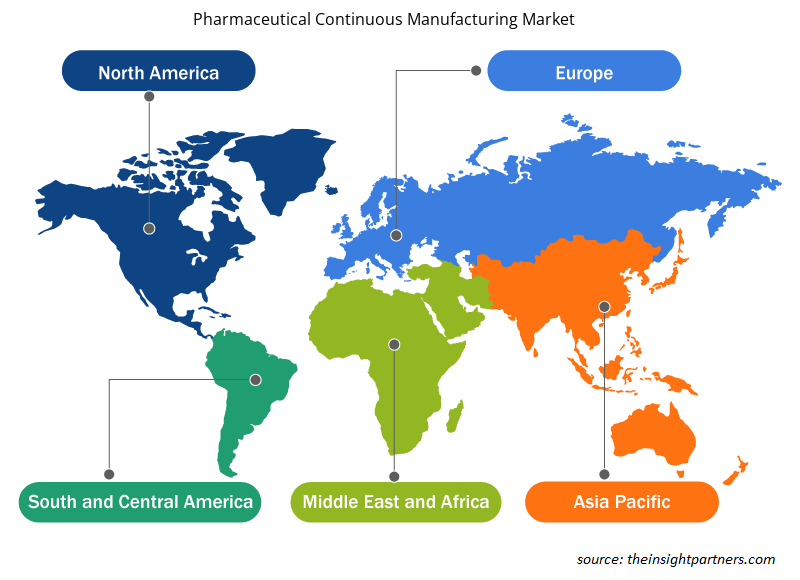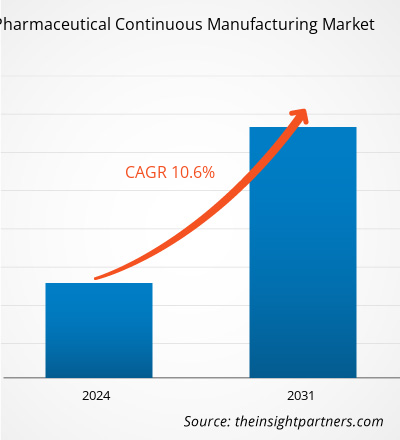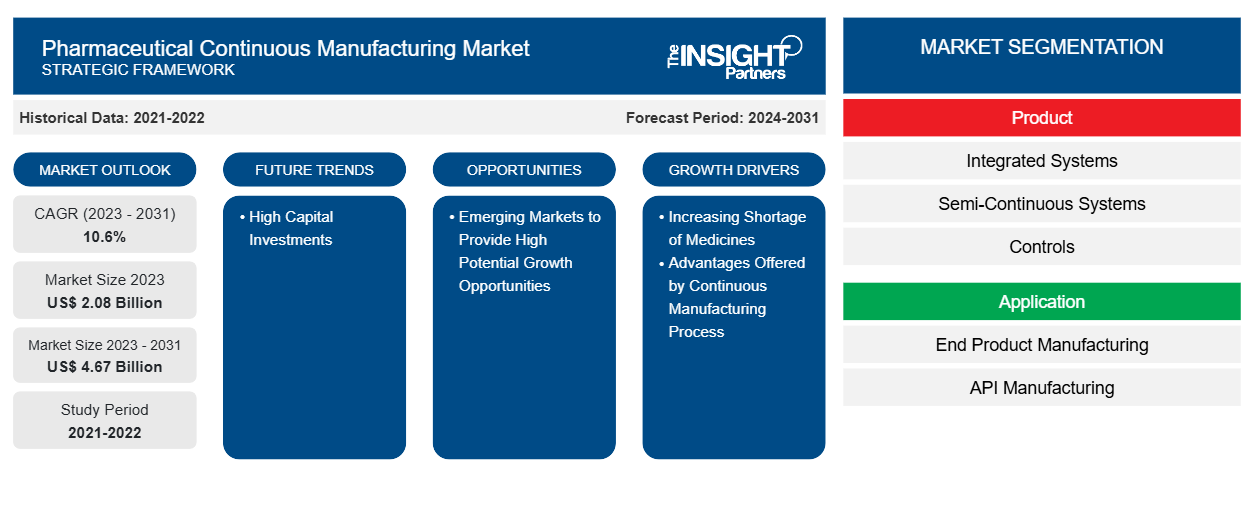预计到 2031 年,制药连续制造市场规模将从 2023 年的 20.8 亿美元增至 46.7 亿美元。预计 2023-2031 年期间,该市场的复合年增长率将达到10.6%。监管机构的支持日益增多、合同和内部制造商越来越多地采用药品制造程序以及连续制造带来的优势可能仍是市场的主要趋势。
制药连续生产市场分析
制药公司不断投资创新制造技术,以获得竞争优势并保持市场领先地位,从而推动连续制造市场的发展。连续制造使制药公司能够更好地控制其生产过程,有助于提高最终产品的质量和一致性,从而减少偏差、浪费、节省返工时间和召回成本。制药连续制造可以提高最终产品的质量,增强过程控制,并允许实时发布测试。欧洲药品管理局 ( EMA ) 和美国食品药品管理局 ( FDA ) 是越来越倾向于在制药行业使用连续制造的监管机构。此外,由于通过自动化、系统控制、数据分析和过程分析技术 (PAT) 手段提供的改进的过程监控、控制和优化,连续制造在制药行业变得更具吸引力和实用性,从而推动了市场的发展。
制药连续生产市场概览
作为减少压力、减少药物开发时间和成本的可行解决方案,连续制造在制药行业中得到了广泛应用,同时还能保持最终产品质量和供应。因此,由于这些优势,连续制造市场正在健康增长。此外,美国食品药品管理局 (FDA) 不断推出推广使用连续制药制造系统的举措,以及连续制造系统相对于批量制造的众多优势,是推动市场增长的一些主要因素。然而,另一方面,制药连续制造系统的高成本实施可能会阻碍市场增长。
定制此报告以满足您的需求
您可以免费定制任何报告,包括本报告的部分内容、国家级分析、Excel 数据包,以及为初创企业和大学提供优惠和折扣
-
获取此报告的关键市场趋势。这个免费样品将包括数据分析,从市场趋势到估计和预测。
制药连续生产市场驱动因素和机遇
连续制造工艺优势惠及市场
由于对生物制剂和灵活制造替代品的需求不断增长,制药连续制造正受到欢迎并变得越来越重要。正在向连续制造程序过渡的公司正在迅速获得 FDA 的批准。连续制造过程具有许多优势,包括时间效率高、减少能源需求和浪费以及提高生产力。此外,由于制造过程中只涉及很少的人,该过程降低了人为错误的风险。因此,由于连续制造提供的上述优势,市场预计在未来几年将增长。
新兴市场提供高潜力增长机会
亚太地区、中南部等地区正在兴起生物制药行业具有吸引力的外包地点。中国和印度的制造和运营成本较低,这是推动亚太地区市场增长的重要因素。由于两国生物制药行业近期的增长,中国和印度都对市场的未来前景持乐观态度。2020 年 1 月,药 明康德的子公司合全药业有限公司在中国开设了一家新的大型寡核苷酸活性药物成分 (API) 制造工厂。因此,适合生物制药行业的新兴市场很可能成为制药连续制造市场中具有高潜力的增长和收入来源。
制药连续制造市场报告细分分析
有助于得出制药连续制造市场分析的关键部分是产品、应用和最终用户。
- 根据产品,制药连续制造市场分为集成系统、半连续系统和控制系统。集成系统部分在 2023 年占据最大的市场份额,预计在预测期内将实现最高的复合年增长率。
- 根据应用,市场分为最终产品制造和API 制造。最终产品制造部分进一步分为固体剂量制造和液体剂量制造。最终产品制造部分在 2023 年占据了最大的市场份额。然而,API 制造部分预计在 2021-2031 年期间的复合年增长率最高。
- 根据最终用户,制药连续制造市场分为全面制造公司和研发部门。全面制造部门在 2023 年占据最大市场份额,预计在预测期内将实现最高复合年增长率。
医药连续制造市场份额地域分析
制药连续制造市场报告的地理范围主要分为五个区域:北美、亚太、欧洲、中东和非洲、南美和中美。
北美一直主导着制药连续生产市场。导致北美制药连续生产市场增长的因素包括:FDA 越来越多地支持推广连续生产而非批量生产,该地区药品短缺日益严重,以及有制药巨头有能力承担建立连续生产工艺的大量初始投资。几十年来,美国大多数行业都采用了连续生产工艺。美国在北美占据主导地位,原因包括采用连续生产程序的制药公司数量不断增加,生产技术领域的进步,以及这些设备为扩大产量提供的效率。此外,美国 FDA 还采取了各种举措,推动美国制药行业的连续生产。
制药连续制造市场区域洞察
Insight Partners 的分析师已详细解释了预测期内影响制药连续制造市场的区域趋势和因素。本节还讨论了北美、欧洲、亚太地区、中东和非洲以及南美和中美洲的制药连续制造市场细分和地理位置。

- 获取制药连续制造市场的区域特定数据
制药连续制造市场报告范围
| 报告属性 | 细节 |
|---|---|
| 2023 年的市场规模 | 20.8亿美元 |
| 2031 年市场规模 | 46.7 亿美元 |
| 全球复合年增长率(2023 - 2031) | 10.6% |
| 史料 | 2021-2022 |
| 预测期 | 2024-2031 |
| 涵盖的领域 |
按产品
|
| 覆盖地区和国家 |
北美
|
| 市场领导者和主要公司简介 |
|
市场参与者密度:了解其对商业动态的影响
制药连续制造市场正在快速增长,这得益于终端用户需求的不断增长,这些需求源于消费者偏好的不断变化、技术进步以及对产品优势的认识不断提高等因素。随着需求的增加,企业正在扩大其产品范围,进行创新以满足消费者的需求,并利用新兴趋势,从而进一步推动市场增长。
市场参与者密度是指在特定市场或行业内运营的企业或公司的分布情况。它表明相对于给定市场空间的规模或总市场价值,有多少竞争对手(市场参与者)存在于该市场空间中。
在制药连续生产市场运营的主要公司有:
- GEA 集团
- 科倍隆有限公司
- 格律克股份公司
- 格拉特有限公司
- 细川密克光集团
- 芒森机械有限公司
免责声明:上面列出的公司没有按照任何特定顺序排列。

- 获取制药连续制造市场顶级关键参与者概览
制药连续生产市场新闻和最新发展
通过收集主要和次要研究后的定性和定量数据来评估制药连续制造市场,其中包括重要的公司出版物、协会数据和数据库。以下列出了制药连续制造市场的一些发展情况:
- 韩国合同开发和制造组织 (CDMO) SK Bioscience 已开始扩建位于韩国庆尚北道安东的 L House 疫苗制造工厂,扩建面积约为 4,200 平方米,该工厂将作为肺炎球菌结合疫苗候选药物 GBP410 的生产基地,该疫苗由 SK Bioscience 和赛诺菲共同开发,两家公司共同投资扩建。 (SK Bioscience,新闻稿,2024 年 3 月)
- 美国基本药物公益公司 Phlow Corp. 宣布与弗吉尼亚联邦大学 (VCU) 全民药物研究所和 AMPAC Fine Chemicals 建立战略联盟,为小分子药物产品提供合同连续制造研发 (R&D) 服务。除了强大且不断增长的内部能力外,Phlow 成熟、创新且经验丰富的战略合作伙伴网络还将利用最先进的技术和独特的行业见解,为各个开发阶段的小分子活性药物成分 (API) 和注册起始物料 (RSM) 提供高质量的美国先进制造解决方案。(Phlow Corp.,新闻,2022 年 3 月)
制药连续制造市场报告范围和交付成果
“制药连续生产市场规模和预测(2021-2031)”报告对以下领域进行了详细的市场分析:
- 范围内涵盖的所有主要细分市场的全球、区域和国家层面的制药连续制造市场规模和预测
- 制药连续制造市场趋势以及市场动态,如驱动因素、限制因素和关键机遇
- 详细的 PEST 和 SWOT 分析
- 制药连续制造市场分析涵盖主要市场趋势、全球和区域框架、主要参与者、法规和最新市场发展
- 行业格局和竞争分析,涵盖市场集中度、热图分析、知名参与者以及制药连续制造市场的最新发展
- 详细的公司简介
- 历史分析(2 年)、基准年、预测(7 年)及复合年增长率
- PEST和SWOT分析
- 市场规模、价值/数量 - 全球、区域、国家
- 行业和竞争格局
- Excel 数据集
近期报告
客户评价
购买理由
- 明智的决策
- 了解市场动态
- 竞争分析
- 客户洞察
- 市场预测
- 风险规避
- 战略规划
- 投资论证
- 识别新兴市场
- 优化营销策略
- 提升运营效率
- 顺应监管趋势























 获取免费样品 - 制药连续制造市场
获取免费样品 - 制药连续制造市场